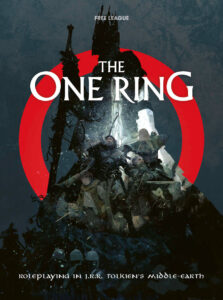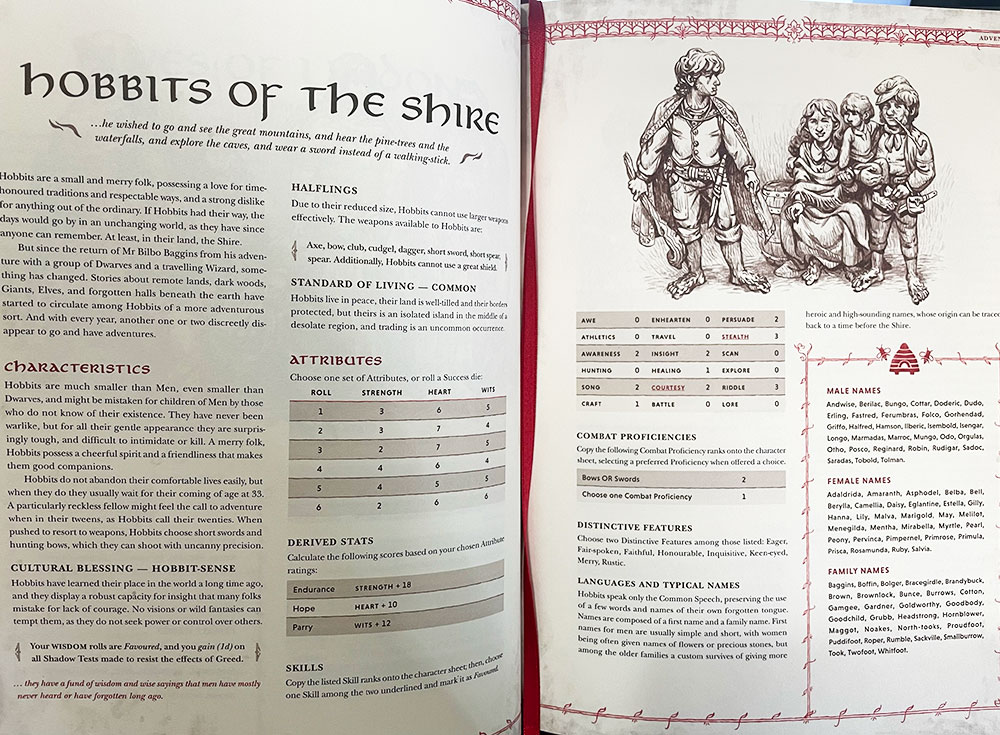 Lord of the Rings holds a special place in my heart and is one of my favorite fantasy series of all time. So, I was excited to read and get a chance to play The One Ring RPG from Free League. I have a bit of experience with different RPG systems and had even played the Alien RPG by Free League as well, so reading through and playing a quick game of One Ring was interesting. For my review I want to focus on the mechanics that are different and my experience playing through one of the starting scenarios as a character player.
Lord of the Rings holds a special place in my heart and is one of my favorite fantasy series of all time. So, I was excited to read and get a chance to play The One Ring RPG from Free League. I have a bit of experience with different RPG systems and had even played the Alien RPG by Free League as well, so reading through and playing a quick game of One Ring was interesting. For my review I want to focus on the mechanics that are different and my experience playing through one of the starting scenarios as a character player.
RPG System Overview:
The time-period of The One Ring is set in the 80 years between The Hobbit and The Lord of the Rings. Mainly the adventures will take place in Eriador during this time. While you won’t be immediately fighting against the hordes of Mordor, the tentative, almost mystical environment in the wilds is extremely atmospheric while adventuring, and not knowing what is around every corner makes player planning a major part of the game.
As with most pen and paper RPGs, you will need a player to run the game (the Loremaster) and each other payer will create a hero from Middle Earth. There are a handful of choices in the game for players to choose a heroic culture and a calling. Heroic cultures consist of Bardings, Dwarves of Durin’s Folk, Elves of Lindon, Hobbits of the Shire, Men of Bree, and Rangers of the North. Callings are like classes in other RPG games. Some of the callings in The One Ring are Scholar, Champion, Treasure Hunter, and Warden.
 Your culture will dictate your attributes, skills, and proficiencies. While your calling dictates your favored skills and features but also your Shadow Path which is the tendencies you begin to gain if you fail to resist the Shadow’s influence. Character creation can be a lot of fun with unique combinations that can lead to some dynamic roleplay at the table. When characters receive rewards, they can get Rewards (which upgrade gear) or Virtues (which upgrade their character stats).
Your culture will dictate your attributes, skills, and proficiencies. While your calling dictates your favored skills and features but also your Shadow Path which is the tendencies you begin to gain if you fail to resist the Shadow’s influence. Character creation can be a lot of fun with unique combinations that can lead to some dynamic roleplay at the table. When characters receive rewards, they can get Rewards (which upgrade gear) or Virtues (which upgrade their character stats).
Another section that sets The One Ring apart is setting up a Company. This is basically your fellowship’s stats being fleshed out. You get to select a Patron who could be an influential individual that can support and counsel your company while it goes on its adventures. Not only is this a story hook but it also gives certain bonus stats. You can also set up your base of operations for your company. The last steps of setting up your company is a fellowship rating and fellowship focus. Your rating is a pool of points the company can use to recover hope while adventuring and your focus is your “best friend” in the company. Having a closer companion allows for better assistance bonuses but can also give you shadow points as they are wounded, dragging you down the shadow path of your calling.

The One Ring is broken into two macro-phases: the adventure phase and the fellowship phase. The adventure phase is when the Loremaster frames each scene and develops the adventure the fellowship will go on, while the fellowship phase is when the players narrate what is happening to the Loremaster after they have returned from their adventure and are deciding what to do before the next adventure phase.
Combat is handled in a different way from most RPGs that I have played before. When combat happens during an adventure there are two sequences. The first is there are opening volleys from range weapons, then the close quarters rounds begin. Close quarters rounds are the bread and butter of most combats. Everybody involved in combat gets to select their stance; Forward, Open, Defensive, or Rearward. Each stance moved your action order in the combat and each stance receives certain benefits. Talking with your party and coming up with a strategy based off your skills during combat is a lot more dynamic and fun than just rolling dice and hoping to break through an enemy’s armor. Of course, there are different types of attacks and actions you can do in combat but a lot of that is determined by your chosen stance.
Social encounters are almost handled the same way in The One Ring. Players will meet many folks upon the road and whether they are good or bad the Loremaster will have to determine how the interaction plays out based on the players’ goals, the NPC’s resistance, and the skills of the players. This is where effective roleplay stands out and is rewarded when interacting with NPCs. Players will be able to choose which skills to use and which attitudes to adopt which can result in success or failure.
Finally, there is the traveling mechanics in The One Ring. When the party travels, they can chart their course across a hex map to that location. How the party charts their journey though can result in different encounters and results in the party’s appointed guide making march roles. This makes travel an active process that the whole party can get involved in.
Game Experience:
I was able to play through an intro adventure with my gaming group for The One Ring a little bit ago. I played a hobbit with a short bow who was a warden that protected the edges of the Shire. Our group met up in Bree where we heard rumors of orc activity on the northern road out of town. The character sheets and stats were easy to get a hold of for the one-shot that our Loremaster was running us through. It can seem overwhelming at first since the system is drastically different than some other RPGs that I have played, but when you do need to make checks and find your stats it is easy to do.
We plotted our course, and we selected our Ranger of the North as our guide. We were able to try a couple of shortcuts through some woods on the way to the rumored orc fort. Travel was a lot more involved than I first thought. Having encounters and events aren’t just run of the mil and trying to plot your course with other players made it feel more strategic. Though I could see where this would also cause a Loremaster to do a bit more prepared for the session. We had to be careful of our pacing and I had become exhausted during our travels and became fatigued a bit easier than the rest of the company. Eventually, we emerged at the orc encampment.
 Things got fun as we observed the orcs and decided that a surprise ranged attack for opening volleys would be the best way to go. The Ranger and I unleashed our bows and killed an orc before the camp was aware that they were under attack. We then started choosing our stances. The Ranger moved forward with our other two-party members to fight in close combat, and I hung in the back with the rearward stance allowing me to take shots at the orcs as the party engaged them. During the battle we found ourselves shifting stances and attacks.
Things got fun as we observed the orcs and decided that a surprise ranged attack for opening volleys would be the best way to go. The Ranger and I unleashed our bows and killed an orc before the camp was aware that they were under attack. We then started choosing our stances. The Ranger moved forward with our other two-party members to fight in close combat, and I hung in the back with the rearward stance allowing me to take shots at the orcs as the party engaged them. During the battle we found ourselves shifting stances and attacks.
When the orc captain arrived, we still had to deal with a couple of stragglers in the open and defensive positions but eventually, we were all able to gang up on the orc captain to kill him. We found the plans for orc movements along the Northern edges of Eriador and started on our way back to Bree to let the Rangers know what was going on. My biggest compliment is that the battle wasn’t just us throwing dice and hoping to crack an orcs armor. Making the wrong decisions felt deadly, and we barely felled the orc caption fighting too offensively. We had to coordinate our attacks and stances to make sure we didn’t overextend when outnumbered. More realistic combat felt more rewarding when we finished our mission.
Our Loremaster then explained some of the other systems that we could see such as the Eye of Sauron mechanics and eventually building our character’s gear and experience to take on bigger threats in the wilds of Eriador. It was a fun time and even my friend who isn’t that big into RPGs enjoyed himself.
Final Thoughts:
If you love tabletop RPGs and Lord of the Rings this is an easy decision to start playing. The systems feel fresh and keeps the entire party involved during the session. More than once we found ourselves strategizing and role playing our character traits which resulted in everyone having a great time. You never know what is going to happen when you hit the road and that keeps in spirit with Tolkien’s work. The production quality feels fantastic as well, and I can’t wait to see what other books will be released with this edition. Some of the minor things to keep in mind is that the new system can feel a bit crunchy for new players until they get into the rhythm of gameplay, and it may require some extra preparation by the Loremaster the further the game goes on. Overall, this is a must-have RPG for me.
Final Score: 4.5 Stars – A captivating RPG that brings some fresh, engaging systems and captures the feel of exploring Middle Earth with your friends.
 Hits:
Hits:
• Truly captures the feel and atmosphere of adventuring in Middle Earth.
• Dynamic travel and combat systems.
• Production quality of books feel great.
Misses:
• Rules can be a tiny bit crunchy for less experienced players.
• Currently limited to Eriador for second edition (so far).
• Some extensive Loremaster preparation may be needed.
Source: Board Game Quest







